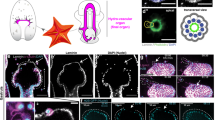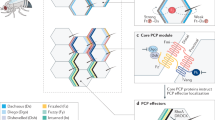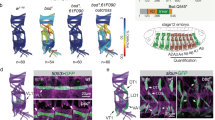Abstract
THE controlled production of cells by mitosis underlies the generation of pattern in a developing organism. Any particular structure is made up of a more or less constant number of cells1,2, which results both from the size of the primordium and from the number of times these founder cells divide. Here I describe a mechanism that regulates cell division during the organogenesis of the insect kidney (Malpighian tubules) in Drosophila melanogaster. A single cell is shown to regulate the division of the other cells making up the tissue. This specialized cell, the tip cell, is set aside early in development and is distinctive both in its position and in its behaviour. Ablation of this cell arrests mitosis in the surrounding cells and prevents further growth. The presence of a tip cell in each tubule seems to be a feature of the development of Malpighian tubules in many insects, and its role in regulating cell division is similar to the control of germ-line mitoses by distal tip cells in the nematode gonad3.
This is a preview of subscription content, access via your institution
Access options
Subscribe to this journal
Receive 51 print issues and online access
$199.00 per year
only $3.90 per issue
Buy this article
- Purchase on Springer Link
- Instant access to full article PDF
Prices may be subject to local taxes which are calculated during checkout
Similar content being viewed by others
References
Maddrelf, S. H. P., Lane, N. J., Harrison, J. B. & Gardiner, B. O. C. Chromosoma 91, 201–209 (1985).
Janning, W., Lutz, A. & Wissen, D. Roux Archiv. Dev. Biol. 195, 22–32 (1986).
Kimble, J. E. & White, J. G. Devl. Biol. 81, 208–219 (1981).
Cooper, K. Proc. natn. Acad. Sci. U.S.A 24, 452–458 (1938).
Gratzner, H. G. Science 218, 474–475 (1982).
Austin, J. & Kimble, J. E. Cell 51, 589–599 (1987).
Yochem, J. & Greenwald, I. Cell 58, 553–563 (1989).
Austin, J. & Kimble, J. Cell 58, 565–571 (1989).
Maine, E. M. & Kimble, J. E. Development 105, 133–143 (1989).
Kimble, J. E. & Austin, J. Cellular Basis of Morphogenesis (Ciba Foundation Symp. 144) 212–226 (Wiley, Chichester, 1989).
Kimble, J. & Ward, S. The Nematode, Caenorhabditis elegans (ed. Wood, W. B.) 191–213 (Cold Spring Harbor, Laboratory, New York, 1988).
Truman, J. W. & Bate, C. M. Devl. Biol. 125, 145–157 (1988).
Karnovsky, M. J. J. Cell. Biol. 27, 137A (1965).
Altman, J. S. & Bell, E. M. Brain Res. 63, 487–489 (1973).
Shields, G. & Sang, J. H. Drosophila Information Service 52, 161 (1977).
Author information
Authors and Affiliations
Rights and permissions
About this article
Cite this article
Skaer, H. Cell division in Malpighian tubule development in D. melanogaster is regulated by a single tip cell. Nature 342, 566–569 (1989). https://doi.org/10.1038/342566a0
Received:
Accepted:
Issue Date:
DOI: https://doi.org/10.1038/342566a0
This article is cited by
-
Functional-metabolic coupling in distinct renal cell types coordinates organ-wide physiology and delays premature ageing
Nature Communications (2023)
-
Drosophila melanogaster: a simple genetic model of kidney structure, function and disease
Nature Reviews Nephrology (2022)
-
Post-embryonic development of the Malpighian tubules in Apis mellifera (Hymenoptera) workers: morphology, remodeling, apoptosis, and cell proliferation
Protoplasma (2018)
-
Posterior gut development in Drosophila: a model system for identifying genes controlling epithelial morphogenesis
Cell Research (1998)
-
Organogenesis in the leech: development of nephridia, bladders and their innervation
Roux's Archives of Developmental Biology (1993)
Comments
By submitting a comment you agree to abide by our Terms and Community Guidelines. If you find something abusive or that does not comply with our terms or guidelines please flag it as inappropriate.



